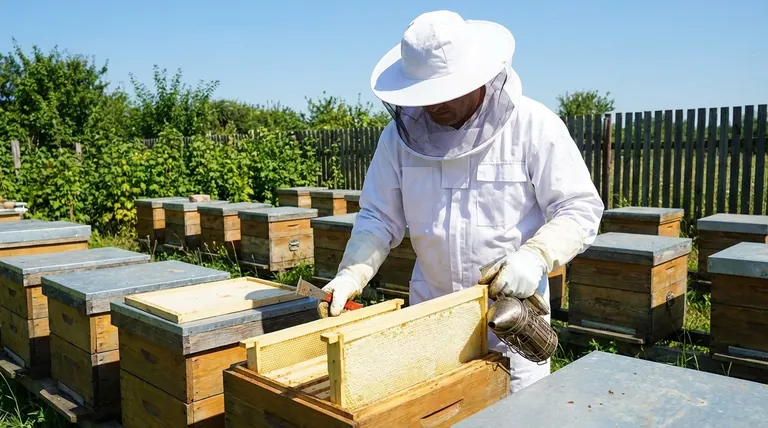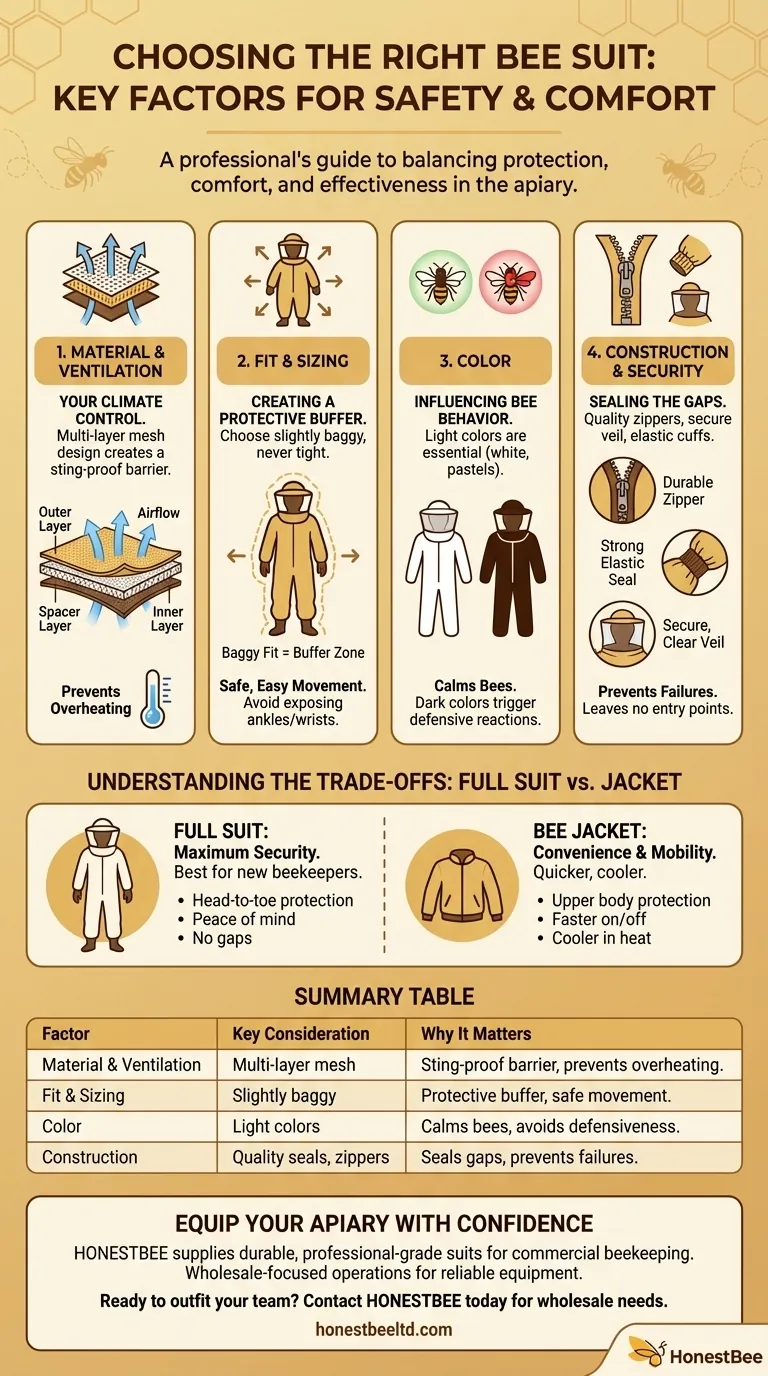When selecting a bee suit, your decision should be guided by four primary factors: the material and its ventilation, the overall fit, the color, and the quality of its construction. These elements work together to ensure your safety and comfort, allowing you to focus on your bees instead of the risk of stings.
Your goal is not just to buy a piece of protective clothing, but to invest in a tool that provides a secure barrier from stings without sacrificing the comfort and mobility you need to work effectively with your hives.

The Core Principles of Bee Suit Design
A bee suit's effectiveness is determined by how well it addresses the fundamentals of beekeeper safety and bee behavior. Understanding these principles is key to making an informed choice.
Material and Ventilation: Your Climate Control
The fabric of your suit is your first line of defense. Modern suits often use multi-layer mesh designs.
A ventilated, 3-layer mesh suit is highly effective. The design creates a significant gap between the outer layer and your skin, making it difficult for a bee's stinger to reach you.
In warmer climates, ventilation is non-negotiable. An aerated or lightweight suit prevents overheating, allowing you to work longer and more comfortably during the hottest parts of the day.
Fit and Sizing: Creating a Protective Buffer
The fit of your suit is a critical safety feature. A tight suit pulls the fabric against your skin, reducing its protective capability.
Always choose a suit that is slightly baggy. This extra space not only allows for easier movement but also creates a crucial buffer zone between you and the bees.
Ensure the suit has enough length in the arms and legs. When you bend, crouch, or stretch, you don't want the cuffs to ride up, exposing your ankles or wrists. If you are between sizes, it is almost always safer to size up.
Color: Influencing Bee Behavior
Color has a direct impact on how bees perceive you. Bees have evolved to react defensively to dark colors, which they may associate with natural predators like bears.
Light colors like white or pastels are essential. These colors are less threatening to bees, helping to keep them calm during hive inspections.
Construction and Security Features: Sealing the Gaps
The small details of a suit's construction determine its reliability. A single failure point can compromise the entire suit.
Look for high-quality, durable zippers. These are common points of failure on cheaper suits. Also, inspect the elastic cuffs at the wrists and ankles, as these create the seal that keeps bees out.
A well-designed veil is also critical. It must offer clear visibility while being securely attached to the suit or jacket, leaving no gaps for curious bees to explore.
Understanding the Trade-offs: Full Suit vs. Jacket
Your level of experience and personal comfort with bees should guide your choice between total coverage and convenience.
The Full Suit: For Maximum Security
A full bee suit offers head-to-toe protection, creating a single, sealed garment. This is often the best choice for new beekeepers who are understandably nervous.
The primary benefit is peace of mind. Knowing there are no potential gaps between a jacket and pants allows you to build confidence while you learn.
The Bee Jacket: For Convenience and Mobility
A bee jacket provides protection for your upper body and head. It is quicker to put on and take off and can be significantly cooler in hot weather.
Many experienced beekeepers, and even confident beginners, find a jacket is sufficient for most tasks. It must be paired with thick trousers and properly secured at the waist to be effective.
Making the Right Choice for Your Goal
Your specific needs and beekeeping environment should dictate your final decision.
- If your primary focus is maximum security as a new beekeeper: Choose a full, light-colored, ventilated bee suit to ensure complete protection and build your confidence.
- If your primary focus is convenience for frequent inspections in a hot climate: A high-quality ventilated jacket offers an excellent balance of safety, comfort, and ease of use.
- If your primary focus is budget without sacrificing core safety: Prioritize a suit with sturdy zippers and strong elastic seals, even if it means fewer bells and whistles like extra pockets.
Ultimately, the right protective gear allows you to move past fear and work with your bees calmly and effectively.
Summary Table:
| Factor | Key Consideration | Why It Matters |
|---|---|---|
| Material & Ventilation | Multi-layer mesh design | Creates a sting-proof barrier; prevents overheating in warm climates. |
| Fit & Sizing | Slightly baggy, not tight | Creates a protective buffer zone; allows for safe, easy movement. |
| Color | Light colors (white, pastels) | Calms bees, as they are defensive toward dark colors. |
| Construction | Quality zippers, elastic seals, secure veil | Prevents failures and seals gaps to keep bees out. |
Equip Your Apiary with Confidence
As a commercial beekeeper or distributor, your team's safety and efficiency are paramount. The right protective gear is an investment in productivity and peace of mind.
HONESTBEE supplies durable, professional-grade bee suits and jackets designed specifically for the demands of commercial beekeeping. Our wholesale-focused operations ensure you get the reliable equipment you need, when you need it.
Ready to outfit your team with gear that protects and performs?
Contact HONESTBEE today to discuss your wholesale needs and discover how our equipment can support your operation's success.
Visual Guide

Related Products
- Cotton Beekeeping Suit and Round Hat with Veil Bee Keeper Protective Gear
- Beekeeping Jacket with Hood and Veil for Beekeepers
- Professional Beekeeping Suit for Kids and Girls Childrens Bee Keeper Suit
- White Beekeeping Protective Suit and Hat with Fencing Veil for Beekeepers
- Beekeeper Cowboy Hat and Veil for Beekeeping
People Also Ask
- Why is a jacket with a hat veil recommended for beekeepers? Essential Protection for Your Face and Neck
- What should be considered regarding the color of beekeeping clothing? Ensure Your Safety and Keep Bees Calm
- Do beekeeping suits completely prevent stings? Maximize Your Apiary Safety with the Right Gear
- What is recommended for beginners in beekeeping regarding protective clothing? A Complete Safety Guide for New Beekeepers
- What are bee suits made of? Choosing the Right Material for Maximum Protection & Comfort



















